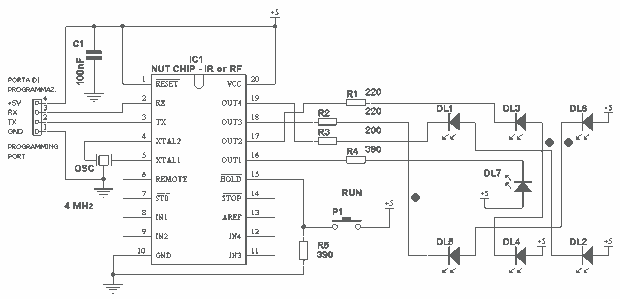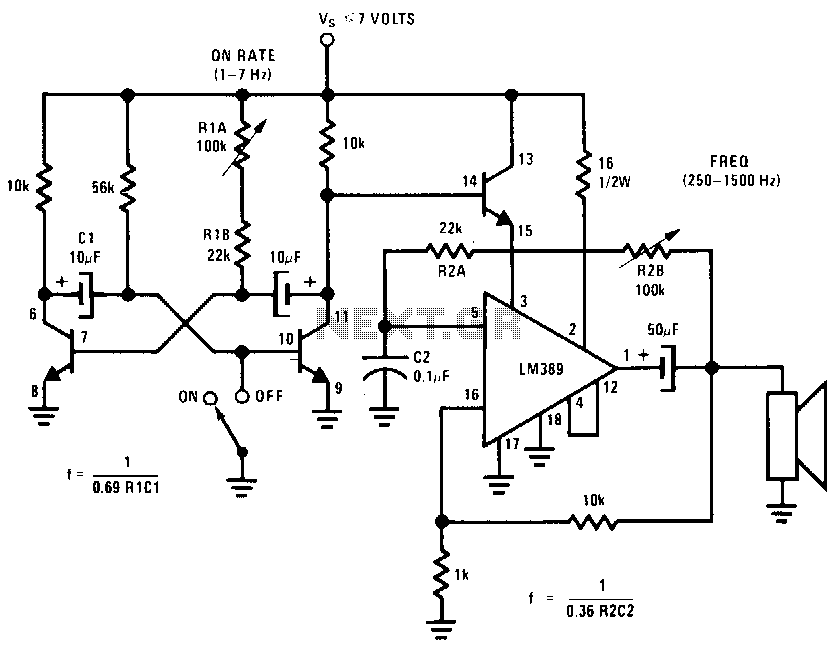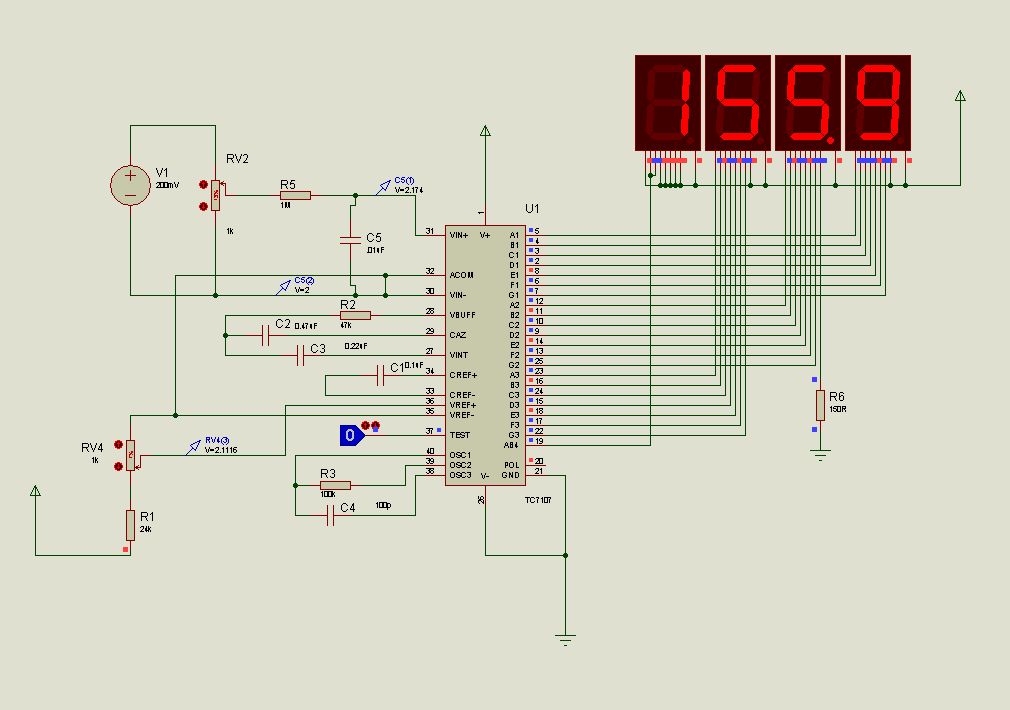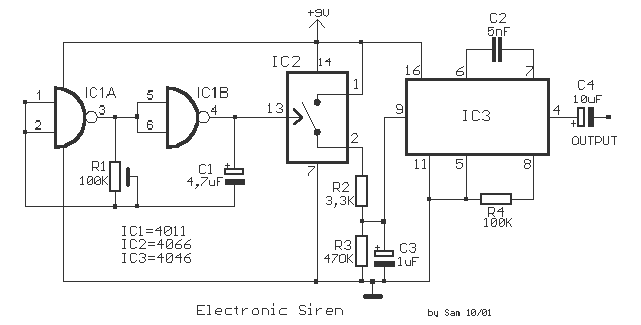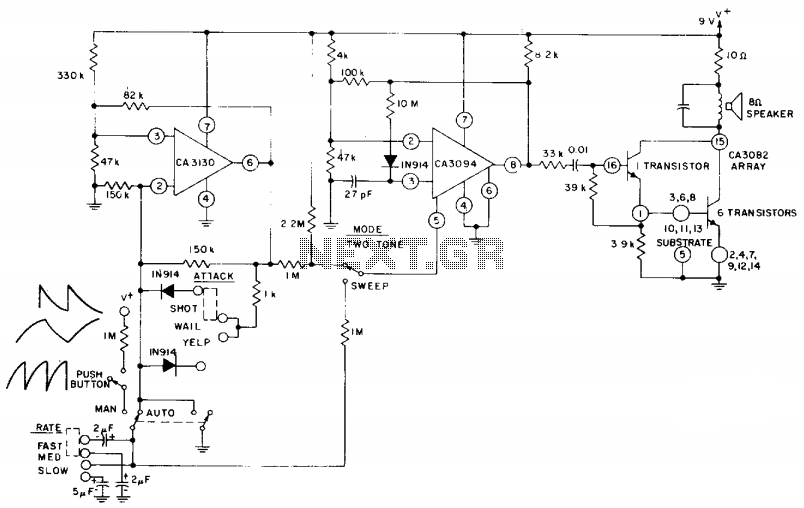
HEE HAW ELECTRONIC SIREN
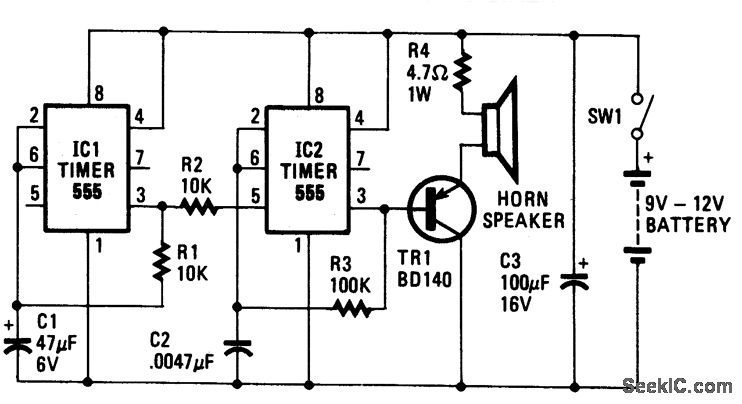
The oscillator based on IC2 generates sound, with its output linked to the base of TR1, which amplifies the signal to drive the speaker. Resistor R4 is included to limit the current through TR1 to a safe level. The oscillation frequency of IC2 is influenced by the values of R3 and C2. Additionally, the voltage supplied to pin 5 of IC2 affects the oscillation frequency; varying this voltage causes the internal circuitry of the IC to reset at different rates, altering the frequency. IC1 also functions as an oscillator but operates at a significantly lower frequency of approximately 1 Hz. Each time IC1 triggers, the voltage at pin 3 increases, which is connected to pin 5 of IC2, prompting IC2 to change its note and produce the "hee-haw" sound characteristic of the siren.
The circuit employs two integrated circuits (IC1 and IC2) to create a sound-generating oscillator system. IC2 serves as the primary sound generator, producing a frequency that is modulated by external components, specifically resistor R3 and capacitor C2. This configuration allows for fine-tuning of the oscillation frequency, which is crucial for achieving the desired sound output.
The output from IC2 is fed into the base of transistor TR1, which acts as an amplifier. The purpose of TR1 is to boost the signal strength sufficiently to drive a connected speaker, ensuring that the sound produced is audible. Resistor R4 plays a critical role in protecting TR1 from excessive current, thereby ensuring reliable operation and preventing damage to the transistor.
Moreover, the frequency of oscillation at IC2 can be dynamically altered by adjusting the voltage at pin 5. This feature introduces versatility into the design, allowing for variations in sound output based on the input voltage. When a varying voltage is applied, it causes the internal circuitry of IC2 to reset at different intervals, resulting in changes to the oscillation frequency.
IC1 operates as a secondary oscillator, generating a much slower frequency of approximately 1 Hz. This slower oscillation is utilized to trigger IC2, as the high voltage at pin 3 of IC1 is connected to pin 5 of IC2. Each time IC1 completes a cycle, it sends a pulse to IC2, prompting it to change its output frequency. This interaction between the two ICs creates the characteristic "hee-haw" sound of the siren, effectively combining the fast oscillation of IC2 with the slower triggering of IC1 to produce a unique auditory effect.
In summary, this circuit design effectively utilizes the properties of oscillators and transistors to create a sound-generating system with adjustable frequency characteristics, ensuring both functionality and protection for its components.The oscillator based on IC2 is responsible for producing the sound. Its output is connected to the base of TR1, which amplifies it to drive the speaker. Resistor R4 is included in the circuit to limit the current through TR1 to a safe and reasonable level. The oscillation frequency of IC2 is partially dependent on the values of R3 and C2. Another factor that governs the frequency of oscillation is the magnitude of voltage fed to pin 5 of IC2. If a voltage of varying magnitude is fed to pin 5, the internal circuitry of the IC is forced to reset at a different rate, which changes the frequency. IC1 is also connected as an oscillator, but it runs much slower than IC2: around 1 Hz. Each time the IC triggers, the voltage at pin 3 goes high. As pin 3 is connected to pin 5 of IC2, this forces IC2 to change its note. That produces the "hee-haw" sound of the siren. 🔗 External reference
The circuit employs two integrated circuits (IC1 and IC2) to create a sound-generating oscillator system. IC2 serves as the primary sound generator, producing a frequency that is modulated by external components, specifically resistor R3 and capacitor C2. This configuration allows for fine-tuning of the oscillation frequency, which is crucial for achieving the desired sound output.
The output from IC2 is fed into the base of transistor TR1, which acts as an amplifier. The purpose of TR1 is to boost the signal strength sufficiently to drive a connected speaker, ensuring that the sound produced is audible. Resistor R4 plays a critical role in protecting TR1 from excessive current, thereby ensuring reliable operation and preventing damage to the transistor.
Moreover, the frequency of oscillation at IC2 can be dynamically altered by adjusting the voltage at pin 5. This feature introduces versatility into the design, allowing for variations in sound output based on the input voltage. When a varying voltage is applied, it causes the internal circuitry of IC2 to reset at different intervals, resulting in changes to the oscillation frequency.
IC1 operates as a secondary oscillator, generating a much slower frequency of approximately 1 Hz. This slower oscillation is utilized to trigger IC2, as the high voltage at pin 3 of IC1 is connected to pin 5 of IC2. Each time IC1 completes a cycle, it sends a pulse to IC2, prompting it to change its output frequency. This interaction between the two ICs creates the characteristic "hee-haw" sound of the siren, effectively combining the fast oscillation of IC2 with the slower triggering of IC1 to produce a unique auditory effect.
In summary, this circuit design effectively utilizes the properties of oscillators and transistors to create a sound-generating system with adjustable frequency characteristics, ensuring both functionality and protection for its components.The oscillator based on IC2 is responsible for producing the sound. Its output is connected to the base of TR1, which amplifies it to drive the speaker. Resistor R4 is included in the circuit to limit the current through TR1 to a safe and reasonable level. The oscillation frequency of IC2 is partially dependent on the values of R3 and C2. Another factor that governs the frequency of oscillation is the magnitude of voltage fed to pin 5 of IC2. If a voltage of varying magnitude is fed to pin 5, the internal circuitry of the IC is forced to reset at a different rate, which changes the frequency. IC1 is also connected as an oscillator, but it runs much slower than IC2: around 1 Hz. Each time the IC triggers, the voltage at pin 3 goes high. As pin 3 is connected to pin 5 of IC2, this forces IC2 to change its note. That produces the "hee-haw" sound of the siren. 🔗 External reference
